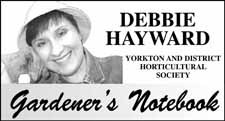Though we have had an amazing winter, even with a few cold days thrown in, we can probably all use a mid-winter gardening pick-me-up. By now we all need to immerse ourselves into a project that is growing and dewy and fragrant with life, and I think I found just the thing.
A dear friend gave me a lovely book entitled "Creative Floral Arranging", and while it is brimming with ideas for beautiful lower arrangements, it also gives instructions on how to make a container garden. Don't we all love container gardens? They're a gift that keeps on giving, because they last and hopefully get better with time! I learned that there are two types of container gardens: those with a variety of foliage plants, and "European" dish gardens which contain a blooming plant. Whichever style we choose, it is important to select plants of various heights, and include at least one plant that cascades. We also should choose plants of various textures, like a bold dracaena with a lacy fern. We should also look for plants with variegated leaves for interest.
It was suggested that African violets are a good choice because they bloom for a good long time; cyclamens are another choice, or orchids if you want a really exotic and elegant dish garden. Crotons are also a good choice for color.
It is important to assess where your container garden is going to be placed, so that you can choose plants that are tolerant of the light and humidity available. Some low light choices include cast iron plant; maidenhair fern; philodendrons; anthiriums; and spathiphyllum (peace lily). Medium light choices are asparagus fern; boston fern; dracena; peperomia; prayer plat; spider plant; and swedish ivy.
And if you have a high light area, you can choose plants like croton, ivies, bromeliads; cyclamen and orchid.
We must choose a container that is at least three inches deep. If we choose a pretty container without drainage holes, we should line the bottom of the container with a half inch or so of pebbles, and then pour our potting soil on top of this. When we have gathered our plant selections, we should try and have a dress rehearsal with them before we take them out of their little pots, so that we don't disturb their roots. Place the planters in the container just to see what arrangement looks best. Once you have an arrangement that is pleasing to you, then you can begin to remove the plants and place them in their new home. Then fill any gaps with potting soil. Do not overfill the container, because you want the plants to grow and fill in nicely, not become crowded. The book suggests that we can also add some little accent piece, like a shell or several beautiful pebbles or a small statue.
Can't you just imagine how much fun this project would be? We could cover the kitchen table with plastic, then spread out our plants and supplies and start "gardening"! Let's try it, but not on February 15: that's the night of the first meeting of the Yorkton and District Horticultural Society for 2012. The meeting begins at 7 p.m. in the Sunshine Room at SIGN on North Street. New members are welcome. Our guest speaker will be Sonja Pawliw telling us all we need to know about growing mushrooms. We hope you can join us!
Next week is Valentine's Day; my precious Mom's birthday. I don't think I will ever stop missing my "Sweet Pea", but I thank her in my heart daily for her love and the wonderful times we shared, many of them connected with the love and lessons of gardening. Thank you, dearest Mom, and happy birthday. And Happy Valentine's Day, gardeners! Treat yourself to a new plant or gardening magazine and have a great week!




